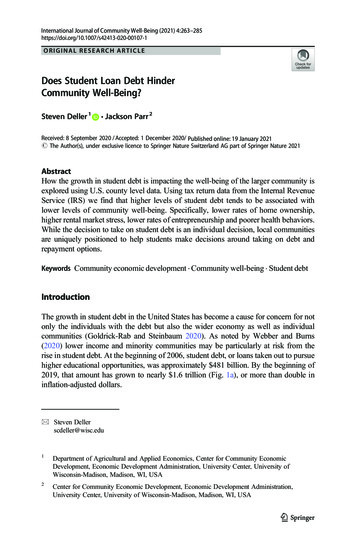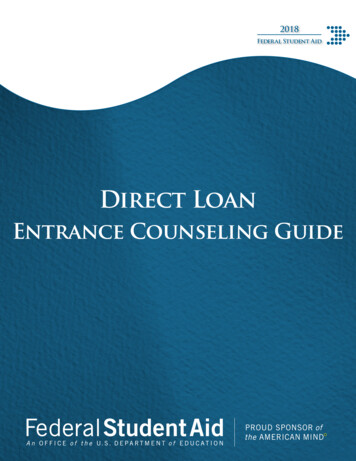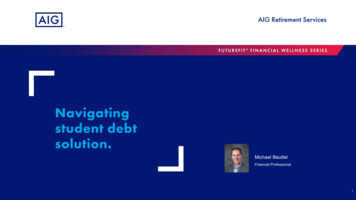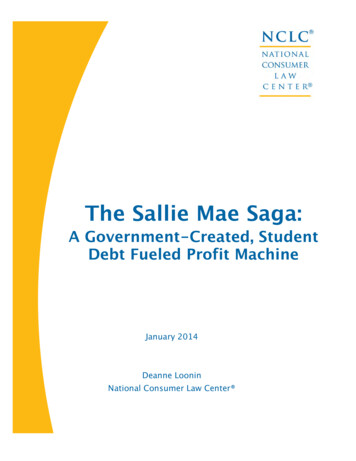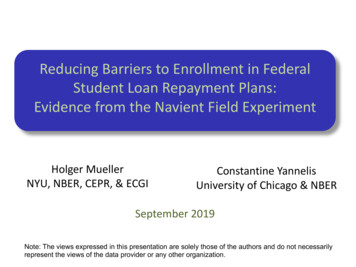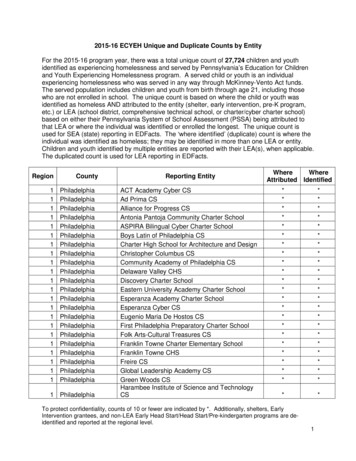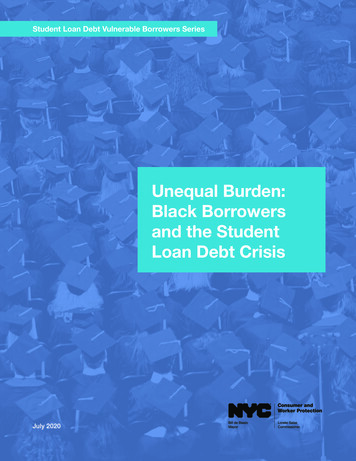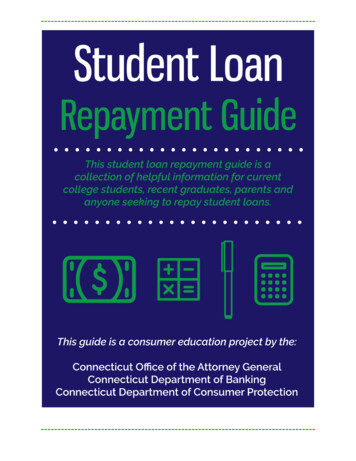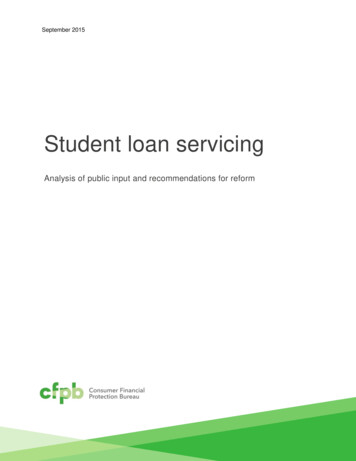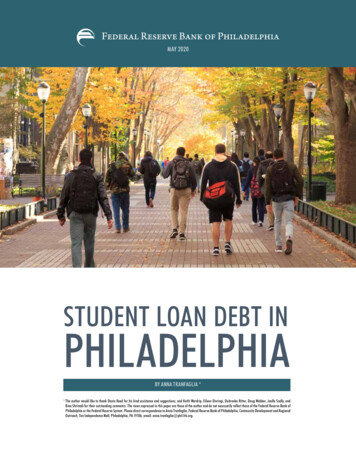
Transcription
MAY 2020STUDENT LOAN DEBT INPHILADELPHIABY ANNA TRANFAGLIA ** The author would like to thank Davin Reed for his kind assistance and suggestions, and Keith Wardrip, Eileen Divringi, Dubravka Ritter, Doug Webber, Joelle Scally, andBina Shrimali for their outstanding comments. The views expressed in this paper are those of the author and do not necessarily reflect those of the Federal Reserve Bank ofPhiladelphia or the Federal Reserve System. Please direct correspondence to Anna Tranfaglia, Federal Reserve Bank of Philadelphia, Community Development and RegionalOutreach, Ten Independence Mall, Philadelphia, PA 19106; email: anna.tranfaglia@phil.frb.org.
IntroductionAs of December 1, 2018, approximately 310,320 Philadelphians collectively owed 11.6 billion in studentloan debt. The share of adults with student loan debt is greater in Philadelphia (25.3 percent) than inPennsylvania (21.2 percent) and in the United States as a whole (17.3 percent). This report providesan in-depth analysis of the geographic distribution of this debt in Philadelphia. It reveals thatindividuals in different zip codes have drastically different experiences in how much they owe, thedegree to which they struggle with repayment, and the extent to which they become delinquent.Increased attention to rising student loan debt has led to a number of national policy proposalsaiming to lessen consumers’ student debt burden. These discussions about changing how weadminister, repay, and possibly forgive federal student loan debt have largely occurred in the absenceof understanding how student borrowers cope with indebtedness. One reason is that data on studentloans are scarce, especially given their substantial share of household debt. Knowing the underlyingrelationship between repayment trends and debt levels can help policymakers better predict whichborrowers might struggle with student debt repayment. This, in turn, aids in designing and evaluatingstudent loan debt policy proposals.In addition to providing new descriptive statistics, this report discusses the implications of studentloan debt for individual borrowers as well as the economy. The main findings include: Student loan debt balances are not equallydistributed geographically. Certain zip codeshave much larger student loan balances thanothers: Balances in the top 20 percent of zipcodes are greater than 25,000, and balancesin the bottom 20 percent of zip codes are lessthan 16,000. However, borrowers in zip codes withrelatively large student loan balancesgenerally do not suffer from higherdelinquency rates. Conversely, delinquentstudent borrowers are less likely to havelarge balances. Both suggest thatdelinquency may arise for reasons otherthan simply the size of the balance, suchas insufficient income. The highest student loan balances are amongthe 36–45 year old cohort, not college-ageborrowers (18–25). Additionally, even the 65and older cohort has higher mean studentloan balances than college-age borrowers.This suggests that paying for a dependent’shigher education is becoming increasinglycommon. It is also consistent withpostgraduate education generallyproducing larger levels of debt.2 STUDENT LOAN DEBT IN PHILADELPHIA Borrowers living in zip codes in the lowestincome quintile experienced higher rates ofsevere delinquency. One in five student loanborrowers were severely delinquent inDecember 2018. An additional 10 percent ofborrowers were delinquent but not severelydelinquent. Only 16 percent of borrowersliving in these zip codes made payments ontime and experienced decreasing studentdebt balances. The highest rates of delinquency were in zipcodes with high percentages of black andHispanic residents. In December 2018, 29.6percent of borrowers were delinquent,including 20 percent who were severelydelinquent, in Philadelphia zip codes withthe highest percentage of black and Hispanicresidents. Just 16 percent of borrowers livingin these zip codes had both a currentrepayment status and a decreasingdebt balance.
Student Loan BackgroundHigher education is — and has historically been — anavenue for economic mobility for Americans. However,education generally does not produce equal resultsfor all students.1 For example, there are notabledifferences in wealth by race and gender even afteraccounting for educational attainment.2 Once more,there is evidence that income depends on choice ofcollege major.3 While the majority of students in theUnited States borrow to fund at least a portion oftheir education expenses,4 there are differences instudent loan take-up rates by socioeconomic level:Low-income students are more likely to use studentloans to help finance the cost of college than peersfrom higher-income families.5Despite the benefits of college, borrowing to financehigher education can still make that education a riskyinvestment for many consumers. In particular, therehas been a growing trend of rising default rates amongstudents who attend schools with significantly lowergraduation rates.6 This is problematic becauseborrowers who do not graduate might experiencemore challenges when repaying their student loans,since they did not attain the qualifications usuallynecessary to improve their career prospects.Nationally, student loan debt has more than doubledin the previous decade and is now the second-largestsource of consumer debt.7 Student loans have several1Darrick Hamilton, William Darity Jr., Anne E. Price, Vishnu Sridharan, and Rebecca Tippett(2015), Umbrellas Don’t Make It Rain: Why Studying and Working Hard Isn’t Enough for BlackAmericans, New York: The New School.2Jhumpa Bhattacharya, Anne Price, and Fenaba Addo (2019), Clipped Wings: Closing theWealth Gap for Millennial Women, Asset Funders Network, available at assetfunders.org/wp-content/uploads/AFN 2019 Clipped-Wings Brief.pdf.3Douglas A. Webber, (2016), “Are College Costs Worth It? How Ability, Major, and DebtAffect the Returns to Schooling,” Economics of Education Review, 53, pp. 296–310.4Board of Governors of the Federal Reserve System (2019), “Student Loans and Other EducationDebt,” Board of Governors, nd-other-education-debt.htm.5Sara Goldrick-Rab (2016), Paying the Price: College Costs, Financial Aid, and the Betrayal of theAmerican Dream. Chicago: University of Chicago Press.6Rajashri Chakrabarti, Michael Lovenheim, and Kevin Morris (2016), “Who Falters atStudent Loan Payback Time?” Liberty Street Economics blog, falters-at-student-loan-payback-time.html.7Federal Reserve Bank of New York, Quarterly Report on Household Debt and Credit (2019Q1).dissimilarities compared with other credit productsthat can both be beneficial and harmful for borrowers.First, student loans are unsecured (i.e., there is nocollateral), and the majority of student loans made tostudents directly (as opposed to loans designed forfamily members to take out on behalf of students) arenot underwritten. Therefore, students’ credit historiesare not taken into account because the federal studentloan program is available to all enrolled students. As aresult, more individuals can access college. Given thesubstantiated disparities in accessing other types ofcredit in the U.S.,8 the relative ease of accessing creditfor higher education opens the doors for many.9Further, student loans are normally not dischargedin bankruptcy. While it is legally possible to dischargethis debt, it is rarely done in practice.10 As a result,severely delinquent debt from a student loan tradeline stays on a consumer’s credit report for yearslonger than severely delinquent debt from other typesof trade lines, such as credit cards or auto loans.11The recent ballooning of student loan debt has bothmacro and micro effects. At the macro level, studentloan debt is the second-highest consumer debtcategory in the U.S., with consumers owing 1.49trillion.12 This is partially due to the growth of studentloan debt throughout the financial crisis (because ofthe lack of underwriting on most federal student loansand increasing tuition costs), the same period inwhich the volumes of other types of debt waned.13This growth is also due to the difficulty of dischargingfederal student loan debt. As delinquency ratesincrease and remain high, student loan debtbecomes a greater liability and cost to bothborrowers and taxpayers.8Patrick Bayer, Marcus Casey, Fernando Ferreira, and Robert McMillan (2017), “Racialand Ethnic Price Differentials in the Housing Market.” Journal of Urban Economics, 102,pp. 91–105.9Alix Carlin and Eileen Divringi (2018), “Home Improvement Lending inthe Third District: Patterns by Income, Race, and Gender,” Cascade Focus: pp. 1–20.10Borrowers must complete a three-part hardship test to determine if repayment wouldcause “undue hardship.”11A trade line is a credit industry term for an account — in this case, a trade line is onestudent loan account.12Federal Reserve Bank of New York, Quarterly Report on Household Debt and Credit (2018Q4).13Federal Reserve Bank of New York, Quarterly Report on Household Debt and Credit (2019Q1).Federal Reserve Bank of Philadelphia 3
Research suggests that student loan balances canalso affect other large investments,14 such as buying ahome15 or starting a business.16 Student loan balancescan also prevent borrowers from accessing additionalcredit if their debt-to-income ratio is too high, evenwhen borrowers are making their monthly paymentsin full and on time.On a micro level, credit histories are adverselyaffected for longer periods when borrowers strugglewith student loan repayment than they are with otherdebt instruments. Debt and delinquency can alsoimpact individuals in other facets of day-to-day life,as well. Credit scores are often used by employerswhen hiring17 and by landlords when renting.18 Highstudent loan balances and delinquencies cannegatively affect these outcomes, particularlysince some types of severely delinquent studentloan trade lines remain on credit records until thebalance has been repaid.19About the DataThis report uses student loan data from theFederal Reserve Bank of New York Consumer CreditPanel/Equifax Data (CCP). This anonymous data set isa 5 percent sample of individual-level credit reportsfrom Equifax and contains quarterly information on thenumber of accounts, debt balances, repayment history,and Equifax Risk Score. The student loan componentof the CCP includes quarterly data on the loan balance,payment, origination date, and default status for eachstudent loan account. I construct total studentloan balances, outstanding debts, and additionalinformation about student borrowers by aggregatingup to the consumer level. The CCP contains loansoriginated and disbursed by the Department ofEducation (federal loans) as well as private loans, butare not disaggregated within this report. The CCP dataare supplemented with population, median income,educational attainment, race, and ethnicity for eachzip code tabulation area (ZCTA) from the CensusBureau’s American Community Survey (ACS) 2013–20175-year estimates.20Student loan–level data are aggregated to boththe student and zip code level within this analysis.Additionally, adjustments are made for jointly heldloans. 21 Student loan trade lines are defined asdelinquent when a payment hasn’t been receivedin 90 or more days and severely delinquent when apayment hasn’t been received in 270 or more days.While other credit trade lines are considereddelinquent after one missed monthly payment,student loan servicers rarely report 30 days past dueand 60 days past due delinquencies to the three creditbureaus. Therefore, delinquency is defined as threemissed payments on a loan22 (or 90 days past due).23While this report is unique in that it examines studentloan debt with small geographies in Philadelphia,there are still many variables unaccounted for. Race,gender, employment status, income repayment planstatus, degree completion, and school type are onlya few of the missing variables that are needed to fullyunderstand student loan borrowing and repayment.Therefore, additional research is needed to providea fuller understanding of borrowers’ experiences withstudent debt.14Marco Di Maggio, Ankit Kalda, and Vincent Yao (2019), “Second Chance: Life withoutStudent Debt,” National Bureau of Economic Research Working Paper 25810.15Rajashri Chakrabarti, Nicole Gorton, and Wilbert van der Klaauw, “Diplomas toDoorsteps: Education, Student Debt, and Homeownership,” Liberty Street Economics omeownership.html.16Brent W. Ambrose, Larry Cordell, and Shuwei Ma (2015), “The Impact of Student Loan Debt onSmall Business Formation,” Federal Reserve Bank of Philadelphia Working Paper No. 15-26.20In the city of Philadelphia, ZTCAs correspond to five-digit zip codes for the entire city.We use the terms zip code and ZCTA interchangeably.17Dean Corbae and Andrew Glover (2018), “Employer Credit Checks: Poverty Traps VersusMatching Efficiency,” National Bureau of Economic Research Working Paper No. 25005.21For loans with a cosigner, the balance is divided in half for each borrower before aggregating upto the consumer level, as to not incorrectly report the loan balance as twice its amount.18Sarena Goodman, Alice Henriques, and Alvaro Mezza (2017), “Where Credit is Due:The Relationship Between Family Background and Credit Health,” Board of Governorsof the Federal Reserve System Finance and Economics Discussion Series 2017-032, doi.org/10.17016/FEDS.2017.032.22Kristin Blagg (2018). Underwater on Student Debt, Washington, D.C.: Urban Institute,available at ent-debt.23Dubravka Ritter (2018), Student Loan Repayment: Research, Data, and Policy, FederalReserve Bank of Philadelphia, available at tudent-loan-repayment/conference-summary.pdf?la en.19Federal Student Aid, “Student Loan Delinquency and Default,” U.S. Department ofEducation, studentaid.gov/manage-loans/default.4 STUDENT LOAN DEBT IN PHILADELPHIA
Prevalence of Student Loan Debt in PhiladelphiaPhiladelphia is a city of 1.58 million individuals, of whom 1.22 million are 18 or older. Approximately 310,320, or25.3 percent, of adults had an active student loan in December 2018. The share of adults with student loan debtis large, but it is not driven by a handful of zip codes. Instead, Philadelphia’s indebtedness appears to be higherthan in other major cities in almost all zip codes. For example, even the Philadelphia zip codes with the lowestindebtedness (the bottom fifth of all zip codes) have higher indebtedness than the San Francisco24 and New York25zip codes with the highest indebtedness (the top fifth of all zip codes).Figure 1 shows that the share of consumers with student loan debt varies substantially by zip code. Figures 2 and3 reveal differences in educational attainment and incomes by zip code. Together, these three figures suggest that24Federal Reserve Bank of San Francisco and the San Francisco Treasurer’s Office of Financial Empowerment (2019), At What Cost? Student Loan Debt in the Bay Area, Federal Reserve Bank of SanFrancisco, available at loan-debt-in-the-bay-area.pdf.25Federal Reserve Bank of New York and NYC Department of Consumer Affairs Office of Financial Empowerment (2017), Student Loan Borrowing Across NYC Neighborhoods, Federal Reserve Bank of NewYork, available at RE 1. PERCENT OF RESIDENTS WITH STUDENT LOAN DEBT BY ZIP 9129191401913219131191331912119122 191251915119130191391914319152191041912319103 19107191061910219146191471913419137 22.1% 22.1%–24.7% 24.8%–27.5% 27.6%–29.7% 29.7% Insufficient data0 1.25 2.51914219148191455 milesSources: New York Fed Consumer Credit Panel/Equifax,U.S. Census Bureau, American Community Survey1915319112Federal Reserve Bank of Philadelphia 5
there is greater student loan debt prevalence in neighborhoods with higher median incomes and higher levelsof educational attainment, such as Manayunk (zip code 19127) and Graduate Hospital (zip code 19146). Yet highincidence of student loan debt also occurs in zip codes with low household median income levels, such as thosecovering Germantown (zip code 19144) and Brewerytown and Strawberry Mansion (zip code 19121).Despite the general trend of higher student debt prevalence in zip codes with greater educational attainment,one region of the city, Center City, remains an outlier. The majority of Center City zip codes (19102, 19103, 19107,FIGURE 2. SHARE OF ADULTS WITH BACHELOR’S DEGREE OR HIGHER BY ZIP 9129191401913219131191331912119122 191071910319106191471913419137 13.3% 13.3%–22.4% 22.5%–25.7% 25.8%–49.1% 49.1% Insufficient data19142191480 1.25 2.55 miles1914519153191126 STUDENT LOAN DEBT IN PHILADELPHIASources: New York Fed Consumer Credit Panel/Equifax,U.S. Census Bureau, American Community Survey
and 19106) have some of the highest rates of residents with at least a bachelor’s degree in the city but onlymoderate to high rates of indebtedness.Outliers also exist with respect to student loan indebtedness and zip code median household income.Germantown (zip code 19144) and Germantown East (zip code 19138) experience some of the largest ratesof student loan debt prevalence but are in the first and second quintiles, respectively, in medianhousehold income.FIGURE 3. MEDIAN HOUSEHOLD INCOME BY ZIP 9129191401913219131191331912119122 191071910319106191471914219148191451913419137 29,581 29,582– 41,063 41,064– 50,159 50,160– 60,400 60,401 Insufficient data0 1.25 2.55 milesSources: New York Fed Consumer Credit Panel/Equifax,U.S. Census Bureau, American Community Survey1915319112Federal Reserve Bank of Philadelphia 7
BalancesFigure 4 shows that borrowers who live in higher-income zip codes have larger student loan balances, onaverage. A typical borrower in the lowest-income zip codes owes 17,000, while a typical borrower in the highestincome zip codes owes 25,000. The median and average across all Philadelphia student loan balances are 19,235and 37,468, respectively.26The correlation between neighborhood income and student loan balances could be partly explained byeducational attainment: Borrowers with graduate or professional degrees frequently have greater loan balancesthan borrowers with bachelor’s degrees (who in turn often have higher loan balances than non-four-yearcollege degree holders), and more education is often associated with higher earning potential. It could also bethat individuals living in relatively higher-income zip codes are more likely to attend and borrow for college. It isnot possible to determine the direction of this relationship.26Both mean and median are conditional on having at least once active student loan trade line.FIGURE 4. MEDIAN STUDENT LOAN BALANCE BY NEIGHBORHOOD INCOME 30,00024,636 25,000 20,00021,84717,20617,202 0- 29,585 29,586- 40,83518,711 15,000 10,000 5,000 0 40,836- 49,780 49,781- 58,785MEDIAN HOUSEHOLD INCOMESource: New York Fed Consumer Credit Panel/Equifax, American Community Survey8 STUDENT LOAN DEBT IN PHILADELPHIA 58,785
Figure 5 shows median (blue) and average(orange) student loan balances by age cohort. The18–25-year-old cohort has low median and averagestudent loan balances relative to most other cohorts.Borrowing may be relatively low for members of thiscohort in part because they are still in the borrowingphase. Relatedly, graduate school has been shownto be a large driver of student loan debt, and most18-to-25 year olds are still too young to have attendedor completed graduate school.27Figure 5 also shows that the 36–45-year-old cohorthas the greatest median and average balances( 22,749 and 44,241, respectively), consistent27Adam Looney and Constantine Yannelis (2019), “The Consequences of Student Loan CreditExpansions: Evidence from Three Decades of Default Cycles,” Federal Reserve Bank ofPhiladelphia Working Paper 19-32.with national findings.28 The 46–55-year-old and56–65-year-old cohorts have relatively highstudent loan balances, which potentially couldbe explained by a few things. First, individualscould be borrowing for their children’s education.Additionally, individuals in these cohorts could bepaying off student loan debt from additionaleducation obtained later in life. Last, older studentloan borrowers may exist in the data because theyare delinquent and haven’t successfully repaidtheir loans.2928Meta Brown, Andrew Haughwout, Donghoon Lee, Joelle Scally, and Wilbert van der Klaauw(2015), “The Student Loan Landscape,” Liberty Street Economics blog, Federal Reserve Bankof New York, available at libertystreeteconomics.newyorkfed.org/2015/02/the studentloan-landscape.html.29Unfortunately, from the CCP data alone, we are unable to disentangle adults who are borrowingto finance their own education from those who are borrowing to finance their child’s education.FIGURE 5. MEDIAN AND AVERAGE STUDENT LOAN BALANCE BY AGE COHORT 50,00042,98844,24142,654 40,00033,15028,355 30,000 20,00019,46812,72822,71822,74922,51415,49512,560 10,000 018–2526–3536–45Median Balance46–5656–6565 Average BalanceSource: New York Fed Consumer Credit Panel/Equifax, American Community SurveyFederal Reserve Bank of Philadelphia 9
Figure 6 shows that there is great spatial variation in total student loan balances across the city. As withthe zip codes with high shares of people with student loan debt (Figure 1), the zip codes with high medianbalances have relatively high median incomes (Figure 3). There is a large cluster of zip codes with smallmedian student loan balances in North and Northeast Philadelphia.Comparing Figure 6 with Figure 2 also reveals that zip codes with high balances tend to have highereducational attainment. The majority of zip codes in the highest quintile of median student loan balancesare also in the top quintile with respect to the percent of adults with a bachelor’s degree or higher. 30 Thissuggests that individuals with the greatest balances are also likely to have completed their undergraduatedegrees or obtained additional postsecondary education.30Although not apparent from these maps, I calculate that 77.8 percent of the zip codes in the highest quintile of median student loan balances (Figure 6) are also in the top quintile with respect tothe percent of adults with a bachelor’s degree or higher (Figure 2).FIGURE 6. MEDIAN STUDENT LOAN BALANCE BY ZIP 91401913319123191471914219148191451913719122 1912519103 1910719106191021914619134 15,954 15,954– 18,588 18,589– 21,945 21,946– 25,414 25,414 Insufficient data0 1.25 2.55 miles19153Sources: New York Fed Consumer Credit Panel/Equifax,U.S. Census Bureau, American Community Survey10 STUDENT LOAN DEBT IN PHILADELPHIA
Figure 7 shows zip code median loan balances divided by zip code median income to provide a differentperspective on indebtedness and potential ability to repay debt. For example, a 20,000 student loan balancewhen one’s income is 40,000 is generally is more difficult to repay than the same indebtedness level with anincome of 100,000.Comparing Figure 7 with Figure 6 shows that the zip codes with the highest ratios of student loan debt toincome are not always the zip codes with the highest median student loan debt. One case of interest is zipcodes that are in the top quintile with respect to balance but do not have relatively high ratios of student loandebt to median income. The presence of zip codes with high median debt but relatively low ratios suggests thateven though individuals are borrowing a great deal for education, these sums may be manageable, given themedian household income in their neighborhoods. By contrast, many zip codes with high ratios are notlocated in high-income neighborhoods; for example, the cluster located in North Philadelphia.FIGURE 7. MEDIAN STUDENT LOAN BALANCE TO MEDIAN HOUSEHOLD INCOME BY ZIP 9146191341913719122 191251915119139191521910219107191031910619147 35.1% 35.1%–42.2% 42.3%–49.4% 49.5%–68.4% 68.4%1914219148 Insufficient data0 1.25 2.51914519153191125 milesSources: New York Fed Consumer Credit Panel/Equifax,U.S. Census Bureau, American Community SurveyFederal Reserve Bank of Philadelphia 11
DelinquencyIn Philadelphia, 21.5 percent of student loan borrowers were delinquent in the fourth quarter of 2018,meaning they were 90 days or more past due. 31 However, only 7 percent of borrowers were exactly 90 days ormore past due. Thus, the majority of delinquent borrowers have missed many months of payments. 32 Studentloans are less likely to be reported delinquent at earlier stages of delinquency than other types of creditaccounts.Figure 8 shows the distribution of total delinquent balance (for delinquent borrowers) in 5,000 increments.Figure 8 shows that compared with the distribution of all student loan balances, the distribution ofdelinquent balances is skewed toward smaller balances. Approximately 66.7 percent of all delinquentborrowers owe less than 10,000. The median loan balance in delinquency status is 5,876, much lowerthan the median loan balance among all (delinquent and not delinquent) loans in Philadelphia ( 19,235).31Delinquency is defined in this report as 90 or more days past due on at least one student loan.32This means that of those who are at least 90 days past due on one student loan trade line, the majority have missed more than three payments (for example, they could be 120, 180,or 270 days past due).FIGURE 8. DELINQUENT STUDENT LOAN BORROWERS BY LOAN BALANCETHOUSANDS30Philadelphia median among all(delinquent and not delinquent) loans: 19,235252015105K 10–15K 15–20 2K0–25 2K5–30 3K0–35 3K5–40 4K0–45 4K5–50 5K0–55 5K5–60 6K0–65 6K5–70 7K0–75 7K5–80 8K0–85 8K5–90 9K0–95 95– K10 0K100K–10 5 0–5K0Source: New York Fed Consumer Credit Panel/Equifax, American Community Survey12 STUDENT LOAN DEBT IN PHILADELPHIA
Figure 9 shows delinquency rates by zip code. Many of the zip codes with relatively low delinquency ratesare also those with relatively high median incomes (Figure 3) and student loan debt balances (Figure 4). Thispattern suggests that high balances do not necessarily imply high delinquency rates. 33The zip codes with the lowest delinquency levels include relatively wealthy neighborhoods in Center City(zip codes 19102, 19103, 19106, and 19107), Manayunk (zip code 19127), and Chestnut Hill (zip code 19118).Severe student loan delinquency is defined as being 270 days or more past due. In Philadelphia, 67.6 percentof delinquent borrowers are severely delinquent. Severely delinquent borrowers make up a majority of alldelinquent borrowers because severely delinquent student loan debt is seldom discharged; thus, theseborrowers’ severely delinquent status persists in the credit bureau data.3433Susan Dynarski (2016), The Trouble with Student Loans? Low Earnings, not High Debt, Washington, D.C.: Brookings Institution.34A three-part “undue hardship” test is required in order to obtain a discharge. This is rare and difficult in practice.FIGURE 9. PERCENT OF STUDENT LOAN BORROWERS DELINQUENT (90 DAYS PAST DUE) BY ZIP 9129191401913219131191331912119122 191251915119130191391914319152191041912319103 19107191061910219146191471913419137 11.3% 11.3%–15.9% 16.0%–23.5% 23.6%–28.1% 28.1 Insufficient data0 1.25 2.5191425 miles19148Sources: New York Fed Consumer Credit Panel/Equifax,U.S. Census Bureau, American Community Survey191451915319112Federal Reserve Bank of Philadelphia 13
Severely delinquent student loan borrowers receive one chance to rehabilitate their loans in order to curethem; however, this is generally not successful. 35 Rehabilitating a student loan requires the borrower to agree— in writing — with their loan servicer to make nine affordable monthly payments. Payments must be madewithin 20 days of the due date. Over the course of the next 10 months, borrowers must make nine payments(in full). If the borrower completes both steps correctly, then the loans will not be in default.If the loans aren’t cured, then severely delinquent loans can be collected via tax refund or wage garnishment.Additionally, severely delinquent borrowers can struggle with accessing any type of credit in the future. Forthese reasons, financial security is threatened by reaching this delinquency status.Figure 10 shows that borrowers who live in lower-income zip codes are more likely to be severely delinquent(270 or more days past due) than borrowers who reside in higher-income geographies. The zip codes with thelargest share of borrowers in severely delinquent status are located in North and West Philadelphia (Figure 10). It is35Blagg, Underwater on Student Debt.FIGURE 10. PERCENT OF STUDENT LOAN BORROWERS SEVERELY DELINQUENT(270 DAYS PAST DUE) BY ZIP CODE1911619
severely delinquent debt from a student loan trade line stays on a consumer's credit report for years longer than severely delinquent debt from other types of trade lines, such as credit cards or auto loans. 11 The recent ballooning of student loan debt has both macro and micro effects. At the macro level, student
